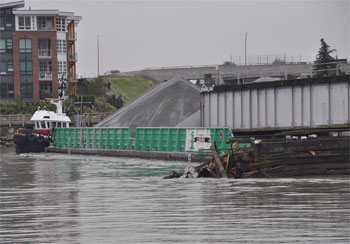A fatigued master and a mate unfamiliar with transiting a difficult passage on the Fraser River were factors that led to the collision of a loaded gravel barge with a British Columbia rail bridge, the Transportation Safety Board (TSB) of Canada said.
A barge being pushed by the tugboat F.W. Wright struck the Queensborough Railway Bridge causing substantial damage on June 28, 2011.
The master had been awake for 22 consecutive hours as a result of conducting lengthy towing duties over the previous day, the TSB said in an investigative report. He handed over the helm to the mate at about 0315 on June 28, prior to a critical maneuver with which the mate was unfamiliar. The captain remained in the wheelhouse, but fell asleep on a settee.
“The mate had limited experience transiting the Queensborough Railway Bridge, and, after having confirmed his approach to the bridge prior to Shoal Point, attempted the transit on his own without seeking assistance from the master,” the TSB report said. “The setting of the barge to the north by the high freshet was underestimated during the approach, and resulted in the barge striking the bridge.”
The 41-foot tug, operated by Mercury Launch & Tug Ltd., was towing the 202-foot barge Empire 40, owned by Lafarge Canada Inc. The barge was laden with 3,600 tons of paving aggregate from Pitt River upstream bound for Mitchell Island in the lower river between Vancouver and Richmond, B.C.
Fraser River water level and velocity predictions indicated that the mid-channel speed of the current at New Westminster was 4.1 and 4.3 knots at 0300 and 0400, respectively.
The narrow gap in the swinging rail bridge is approached from upstream on a curve in the river and vessels then pass through the bridge between Lulu Island on the south side and the mainland shore on the north.
Tugs steer towards the northeast tip of Lulu Island, approximately 750 feet east of the Queensborough Railway Bridge. As the tug and tow near the northeast tip, the deflection of water caused by a submerged anti-silting weir between the tip and Shoal Point sets the tow to the north as it nears the bridge. This is counteracted by steering for the south-side opening.
On approaching the open swing bridge, F.W. Wright’s mate noticed that the barge was not following the intended track, but setting to the north of the transit line through the south channel of the bridge. He attempted to change course and increased engine power. The captain was wakened by the noise and took the wheel, but by then the barge was on a collision course with the protective pier around the bridge support.
Assist tug Harken No. 8, on the port quarter of the barge to keep it clear of the submerged weir and clear of the island, was thus on the wrong side of the barge to attempt to keep it clear of striking the pier.
At 0410, the barge hit and damaged the protection pier. The barge continued on while the swing span drove 33 feet into the gravel pile on the barge deck. The master then activated the abort switch for the towing winch to pay out the towline and moved the tug away from the barge. The barge finally came to a stop after the current pushed it against the south rail line approach.
The bridge center swing span and protection pier sustained extensive damage with the bridge being inoperable for two months, causing major disruptions to railway and river traffic. No one was injured and there was no pollution as a result of this occurrence.
In its final report, the TSB concluded that the master had been awake for approximately 22 hours and “was likely experiencing feelings of fatigue when he handed over the con to the mate prior to a critical stage in the passage.” The TSB noted that the master did not take advantage of the opportunity to rest and sleep after the mate joined the tug.
The TSB also found that in the absence of a safety management system for small commercial vessels, there is an increased probability that risks will remain unidentified and that vessels will be operated in an unsafe manner.
The TSB commented on the fact that there were no formal written company policies or procedures in place for either critical or routine shipboard or shore-based operations.
“When the progress of the towing operation is not continuously monitored and no updates are provided on this operation, as well as when this information is not shared, there is an increased risk that a developing situation may not be identified in time for corrective action to be taken,” the report stated.
When reached by telephone, a spokesman for the Mercury Launch & Tug Ltd., declined to give his name or comment on the TSB report.

